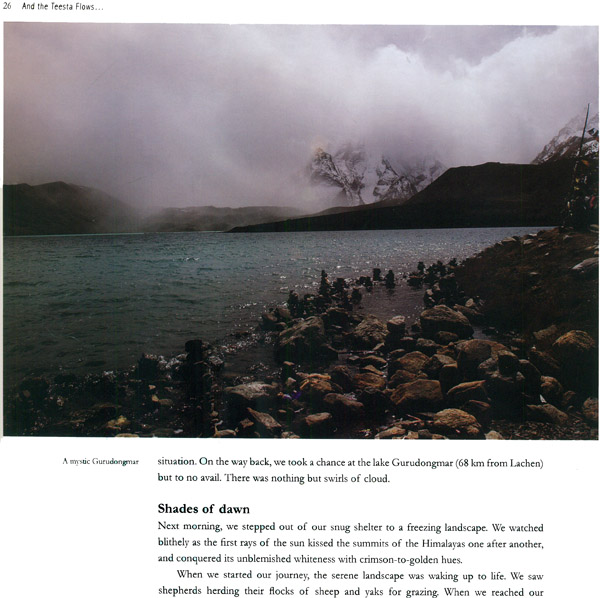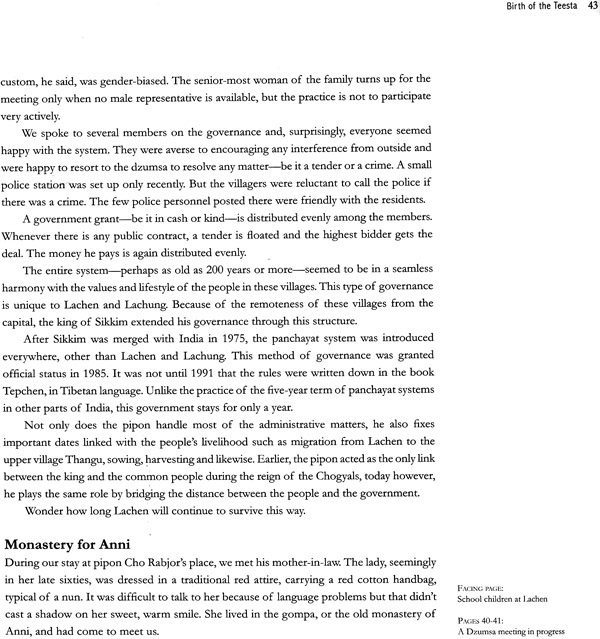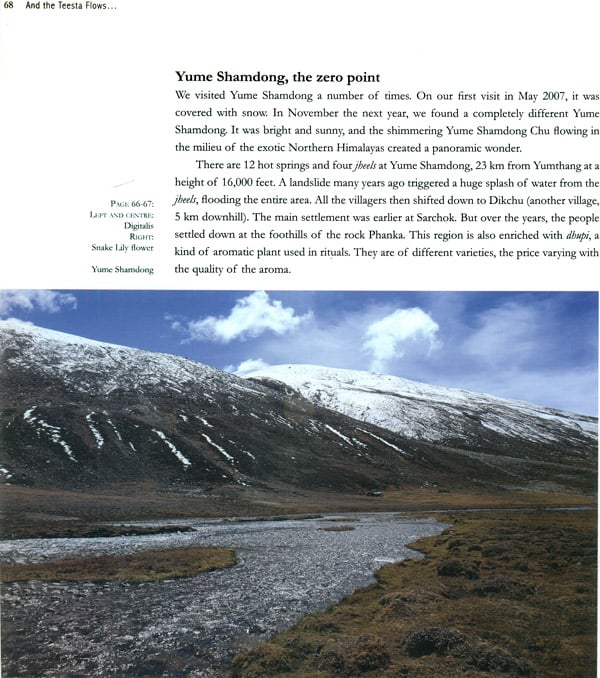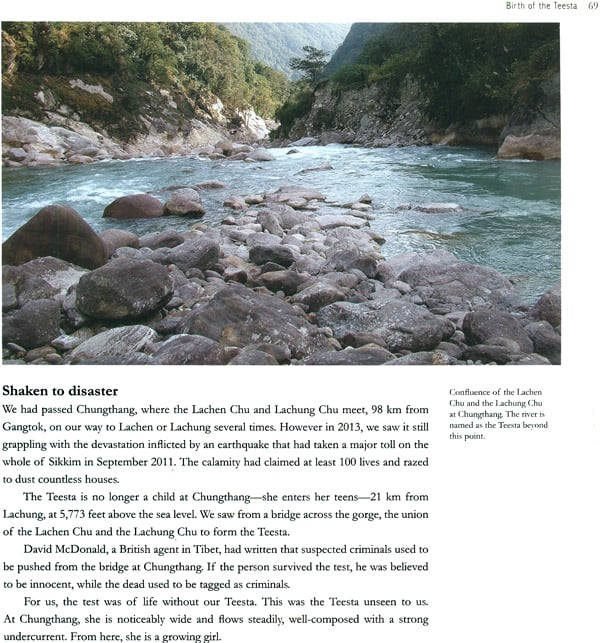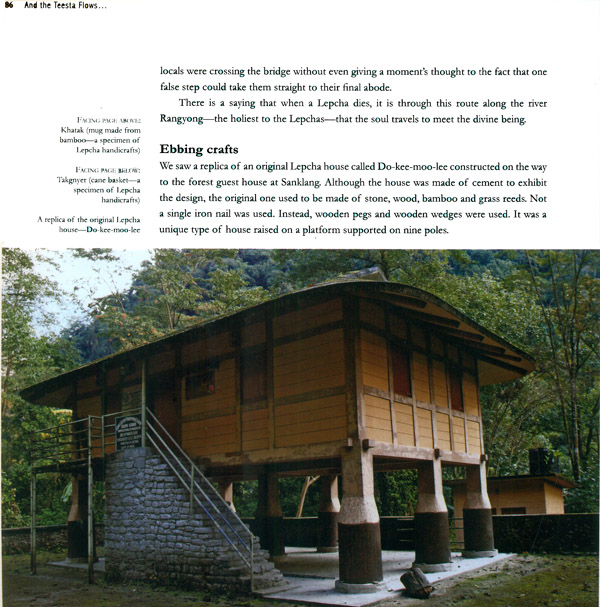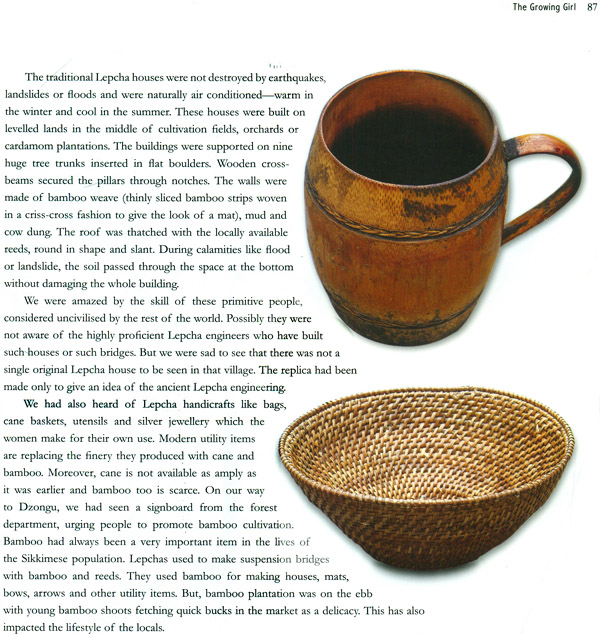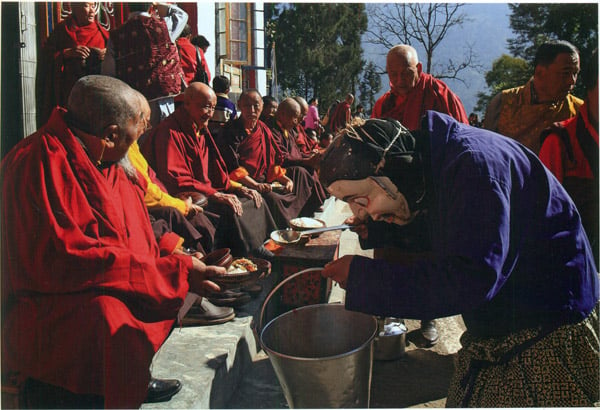
And The Teesta Flows
Book Specification
| Item Code: | NAK647 |
| Author: | Samita Chaudhuri and Utpal Chaudhuri |
| Publisher: | Niyogi Books |
| Language: | English |
| Edition: | 2015 |
| ISBN: | 9789383098705 |
| Pages: | 188 (Throughout Color Illustrations) |
| Cover: | Hardcover |
| Other Details | 9.0 inch x 9.0 inch |
| Weight | 980 gm |
Book Description
About the Book
And the Teesta Flows ... is the biography of a mountain river-the Teesta. The book traces the river's course right form its origin in North Sikkim to its confluence with the Brahmaputra in Bangladesh. However, what lies as an undertone in this narrative is the story of a girl- Teesta, the river her namesake-who lived to see only thirteen summers. Authors Utpal and Samita Chauduri have constantly travelled to the Himalayas seeking a reflection of their daughter in the perennial flow of the river Teesta. Thus begins a story.
Written in the style of a diary without chronology, the book sketches the diversity of the people living by the Teesta, delineating the tales of their philosophies, their life- styles, their livelihoods and their emotions. The anecdotes that find place in the narrative are the authors' first-hand experiences of interactions with them. A memoir, a piece of dedication, an offering in remembrance of a loved one, call it what you may, this book is bound to touch your heart.
About the Author
Samita Chaudhuri did her post-graduation from the Jadavpur University in pharmaceutical technology, followed by a doctoral and post-doctoral research from the Calcutta University. She has served as a quality assurance manager at various pharmaceutical companies and is presently teaching pharmacy at a government polytechnic college. Samita is also a trained rock climber, an experienced high-altitude trekker and a passionate photographer.
Utpal Chaudhuri is an alumnus of Hindu School and a pharmacy graduate from the Jadavpur University.
A university blue in badminton and hockey, he is a passionate photographer. His photographs have earned recognition both within and Outside India. A trained High-altitude trekker with experience in Bengal, Sikkim, Kumaon, Garhwal and Utpal, Utpal has also topped various debate competitions at the national leveL He retired as assistant director of drugs control, West Bengal government, in 2013.
Foreword
They met in college - Utpal and Samita. He infected her with the love of mountains. Together, they went climbing rocks and trekking, and before long she was drawn inexorably to that unearthly paradise suspended from the heavens. As their passion grew, they found a name for their child to be: Teesta - the river born of the mountain in the icy womb of a glacier.
Back in the city, their very own Teesta reminded them of the mountain river - impetuous, swift, undaunted - ever ready to skip over the boulders of her young life; a daredevil like her father, and like Samita a lover of books. She took after them both, ready for the mountains armed with rucksack and tracksuit; a shutterbug and known among friends as a natural leader. Barely eight months old, her parents took her to Sikkim to meet her namesake, and then again when she was just four. The mountains that had transformed Utpal and Samita, had given them the perfect gift - the river-child - a daily reminder of their home away from home.
At 11 Teesta fell sick. A pernicious disease affected her mind and plunged the three into a nightmare from which they emerged two years later - but without Teesta. The river of life disappeared. What was once a bubbly stream was no more than a frozen lake of pain.
Even now, Utpal breaks down as he tells stories about his Teesta. Not a day passes without her thoughts, he says. Time, unlike the clisease, has failed to take her away. I wonder what lies in Samita's vacant gaze. How far back does she see?
It isn't clear why they returned to the mountains. Perhaps it was the draw of a well-trodden path, the lure of the mountain tongue, the call of friends they'd made on the way. Utpal had given up his camera, given up his pet project of documenting his daughter's life along with their travels. They went back to Teesta, and at her banks they found the child they'd lost. "There she was!" - Samita's eyes sparkle. The river enacted the mischief of a little girl, spoke in her voice as she gurgled past the rocks and took two steps instead of one to keep up with her parents. Their daughter's namesake called after them, blending with many more mountain streams but retaining her spirit, reminded them at every bend and as she flowed under bamboo bridges that their Teesta was immortal, eternal.
A new dream was born: to travel with their Teesta from her moment of birth in the lofty mountains, down to where she turns into a young lady and further still into her womanhood. What would she resemble, who'd be her friends, how would she deal with new worlds she'd venture into - how would their Teesta have lived, if she was alive?
Just as the river wasn't simply a river anymore, they put eye and pen together as chroniclers and out of their enchantment was born a new child.
I have turned the pages of this book to travel with Utpal and Samita, gathering up fables and anecdotes and marvelling at the incredible sweep of their journey from mountain to sea. I have heard their short breath on steep slopes and the rush of excitement at each new discovery. I have sensed another traveller, who'd never left their side. But most of all, I've marvelled at the incredible capacity, that only humans may occasionally display, of surmounting pain to create a thing of wonder.
Preface
This book is the biography of a mountain river-the Teesta. Originating in North Sikkim, the Teesta runs through West Bengal and embraces the Brahmaputra in Bangladesh. Like many other rivers, the Teesta too has her own legends, myths and culture as she rolls down through history.
What runs as an undercurrent in this book is the story of a little girl. We, passionate about the hills, had named her after the river. But Teesta, an icon of life to those who had seen her, met her and lived close to her, left us aged only 13. The agony of loss drove us back to the Himalayas only to rediscover our daughter in the flowing streams and in everything that is related to the river. There are many interpretations of the name Teesta. There is a saying that the name comes from the Sanskrit word trisrota, which means three tributaries. In the epics, too, there are mentions of the Teesta, where the word implies trishna or thirst. The Rig Veda refers to the Teesta as shauda neer or eternally restless. It is in the light of these interpretations that we find that the river and the child has become one-Teesta. Thus began the story.
We followed the course of the river Teesta again and again over the last eight years. To us, the Teesta at her origin looks sleepy, much like a newborn baby. Gradually, she emerges from the womb of the glaciers and starts dancing with the vitality of a little girl. We see in the river our Teesta, the child. The river then widens and blooms, like a teenager, rushing towards the plains. It slowly transforms, as if into a young lady, swift and beautiful, and passes through the plains to join the mighty Brahmaputra.
Since the flow of the Teesta is continuous, it is difficult to divide the narrative into chapters. This book is sort of a diary without chronology, delineating the tales of the people living by the Teesta-their philosophy, their livelihood, their emotions. It is remarkable how all these vary with the flow of the river down its course. However, it is necessary to mention that we have not concentrated on geology, politics or the natural diversity. We have only tried to sketch the diversity of the people, and their lifestyle, living by this river. The anecdotes that find place in the narrative are our own experiences of interactions with them and the facts given are mainly narrated by the inhabitants. To us, the river was our child-its course down the hills and through the plains like her life over the years-accordingly, the book has been segmented into three sections:
Birth of the Teesta, The Growing Girl and The Lady.
Contents
| Foreword | 09 |
| Preface | 13 |
| Birth of the Teesta | 17 |
| The Growing Girl | 71 |
| The Lady | 139 |
| Acknowledgements | 186 |
| Bibliography | 187 |
| Index | 188 |
